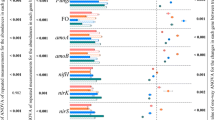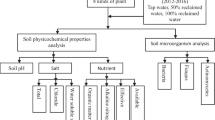Abstract
The present study was conducted to investigate the relationships between meteorological conditions and the disinfection effect of soil solarization in five greenhouses (located in Kaizu City, Gifu, Japan). The specific analysis focused on soil temperature, the population density of Ralstonia solanacearum before and after soil disinfection, the air temperature inside and outside the greenhouse, the amount of solar radiation, and rainfall. The density of R. solanacearum decreased markedly after soil solarization with the average daily soil temperature exceeded 40 °C for 10 consecutive days or more. In the scope of this study, the meteorological conditions required to meet this condition included: a disinfection period of 24 days or more, an average daily air temperature above 28.0 °C, as well as average daily solar radiation exceeding 17.0 MJ m−2. Moreover, with the average daily soil temperature of the soil surface layers exceeded 40 °C for 10 consecutive days or more, the average daily air temperature and average daily solar radiation should be higher than 29.3 °C and 20.2 MJ m−2, respectively. If the mentioned meteorological conditions were met, a fairly good disinfection effect could be achieved. However, if the greenhouse was poorly insulated, or if the solar radiation and air temperature decreased significantly in rainy and cloudy days, the soil was not likely to reach 40 °C or more for 10 consecutive days.




Similar content being viewed by others
References
Abdallah MMF (1991) Control of different weed species at different soil depth with soil solarization. Egypt J Agron (Special Issue) 81–88
Butler DM, Kokalis-Burelle N, Albano JP, McCollum G, Muramoto J, Shennan C (2014) Anaerobic soil disinfestation (ASD) combined with soil solarization as a methyl bromide alternative: vegetable crop performance and soil nutrient dynamics. Plant Soil 378:365–381. https://doi.org/10.1007/s11104-014-2030-z
Cartia G (1987) Risultati della solarizzazione in Sicilia. La Difesa delle Piante 10:189–194
Cascone G, D’Emilio A, Mazzarella R (2012) Polyamide-based film as greenhouse covering in soil solarization. Acta Hortic 927:659–666. https://doi.org/10.17660/ActaHortic.2012.927.81
Castello I, D’Emilio A, Raviv M, Vitale A (2017) Soil solarization as a sustainable solution to control tomato Pseudomonads infections in greenhouses. Agron Sustain Dev 37(6):59. https://doi.org/10.1007/s13593-017-0467-1
D’Emilio A (2017) Soil temperature in greenhouse soil solarization using TIF and VIF as mulching films. Trans ASABE 60(4):1349–1355. https://doi.org/10.13031/trans.12234
Dai YY, Senge M, Yoshiyama K, Zhang PF, Zhang FP (2016) Influencing factors, effects and development prospect of soil solarization. Rev Agr Sci 4:21–35. https://doi.org/10.7831/ras.4.21
DeVay JE (1990) Historical review and principles of soil solarization. In: DeVay JE, Stapleton JJ, Elmore CL (eds) soil solarization. FAO, Rome, pp 2–15
Emilio A (2017) Parametric analysis of soil temperature in a solarization treatment in closed greenhouse. Acta Hortic 1170:243–250. https://doi.org/10.17660/ActaHortic.2017.1170.28
Faostat (2012) http://www.faostat.org. Assessed 15 Oct 14
Genin S, Denny TP (2012) Pathogenomics of the Ralstonia solanacearum species complex. Annu Rev Phytopathol 50:67–89. https://doi.org/10.1146/annurev-phyto-081211-173000
Ghini R, Bettiol W, De Souza NL (1992) Soil solarization for the control of Verticillium dahliae in eggplant. Fitopatol Bras 17:384–388
Giannakou IO, Sidiropoulos A, Prophetou-Athanasiadou D (2002) Chemical alternatives to methyl bromide for the control of root-knot nematodes in greenhouses. Pest Manag Sci 58:290–296. https://doi.org/10.1002/ps.453
Gill HK (2014) Soil Solarization: a natural pest management strategy. Pop Kheti 2(3):153–157
Gill HK, McSorley R (2010) Integrated impact of soil solarization and organic mulching on weeds, insects, nematodes, and plant performance. Proc Fla State Hort Soc 123:308–311
Gill HK, McSorley R, Treadwell DD (2009) Comparative performance of different plastic films for soil solarization and weed suppression. HortTechnology 19(4):769–774. https://doi.org/10.21273/hortsci.19.4.769
Gill HK, Aujla IS, De Bellis L, Luvisi A (2017) The role of soil solarization in India: how an unnoticed practice could support pest control. Front Plant Sci 8:1515. https://doi.org/10.3389/fpls.2017.01515
Horowitz M, Regev Y, Herzlinger G (1983) Solarization for weed control. J Weed Sci 31:170–179. https://doi.org/10.1017/S0043174500068788
Katan J (1981) Solar heating (solarization) of soil for control of soilborne pests. Annu Rev Phytopathol 19(1):211–236. https://doi.org/10.1146/annurev.py.19.090181.001235
Kelman A (1954) The relationship of pathogenicity in Pseudomonas solanacearum to colony appearance on tetrazolium medium. Phytopathology 44(12):293–295
Liu D, He H, Huang HB, Xie JH, Chai TT (2011) Isolation of pathogenic Ralstonia solanacearum from Pogostemon cablin and determination of its pathogenicity. Chin Tradit Herb Drugs 42(8):1596–1599 (in Chinese)
Mahrer Y, Avissar R, Naot O, Katan J (1987) Intensified soil solarization with closed greenhouses: numerical and experimental studies. Agr For Meteorol 41(3):325–334. https://doi.org/10.1016/0168-1923(87)90087-6
McSorley R, Wang KH, Rosskopf EN, Kokalis-Burelle N, HansPetersen HN, Gill HK, Krueger R (2009) Nonfumigant alternatives to methyl bromide for management of nematodes, soil-borne diseases, and weeds in production of snapdragon (Antirrhinum majus). Int J Pest Manag 55(4):265–273. https://doi.org/10.1080/09670870902878400
Melero Vara JM, Blanco Lpez MA, Bejarano Alcazar J, Jimenez Diaz RM (1995) Control of Verticillium wilt of cotton by means of soil solarization and tolerant cultivars in southern Spain. Plant Pathol 44:250–260. https://doi.org/10.1111/j.1365-3059.1995.tb02776.x
Ministry of Agriculture, Forestry and Fisheries Agricultural Structure Improvement Bureau (1997) Land improvement business plan design criteria plan “agricultural water (field)” Standards-plan, Agriculture Woodworking Society 179–185. (in Japanese)
Morgan DP, Liebman JA, Epstein L, Jimenez MJ (1991) Solarizing soil planted with cherry tomatoes vs. solarizing fallow ground for control of Verticillium wilt. Plant Dis 75:148–151. https://doi.org/10.1094/PD-75-0148
Satour MM, Riad FW, Abdel-Hamied AS (1991) Soil solarization and control of plant parasitic nematodes. In: Soil solarization: Proceedings of the first conference on soil solarization, Amman, Jordan (DeVay JE, Stapleton JJ, Elmore CL (eds) FAO plant production and protection paper 109:173–181. https://doi.org/10.1002/hec.807
Shinmura A (2003) The control effect against various soil pests and development of subsoil reduction disinfection method. In: 5th road south agricultural new technology presentation meeting. (in Japanese)
Sonku Y, Nomura Y (1987) Control against the source of first infection of causal agent to vegetables under plastic house 4. Inoculum potential of the plants residues infected by eggplant bacterial wilt and evaluation of solar disinfection to control of infected plants residues. Kyushu Agr Res 49:122
Stapleton JJ (2000) Soil solarization in various agricultural production systems. Crop Prot 19:837–841. https://doi.org/10.1016/s0261-2194(00)00111-3
Stapleton JJ, DeVay JE (1995) Soil solarization: a natural mechanism of integrated pest management. In: Reuveni R (ed) Novel approaches to integrated pest management. Lewis Publishers, Boca Raton, Florida, USA, pp 309–322
Tjamos EC, Paplomatas EJ (1988) Long-term effect of soil solarization in controlling Verticillium wilt of globe artichokes in Greece. Plant Pathol 37:507–515. https://doi.org/10.1111/j.1365-3059.1988.tb02108.x
Triolo E, Vannacci G, Scaramuzzi G (1985) Possibilità di applicazione della solarizzazione del terreno in Italia: indagini sul binomio lattuga—Sclerotinia minor Jagger. La Difesa delle Piante 8:127–140
Triolo E, Vannacci G, Materazzi A (1989) La solarizzazione del terreno in orticoltura. 3. Efficacia nei confronti di Rhizoctonia solani Kuhn in pieno campo. La Difesa delle Piante 12:281–288
Wang S, Yin X, Tang J, Hansen JD (2004) Thermal resistance of different life stages of codling moth (Lepidoptera: Tortricidae). J Stored Prod Res 40:565–574. https://doi.org/10.1016/j.jspr.2003.09.002
Zasada IA, Halbrendt JM, Kokalis-Burelle N, LaMondia J, McKenry MV, Noling JW (2010) Managing nematodes without methyl bromide. Annu Rev Phytopathol 48:311–328. https://doi.org/10.1146/annurev-phyto-073009-114425
Author information
Authors and Affiliations
Corresponding author
Rights and permissions
About this article
Cite this article
Dai, Y., Zhang, P., Ito, K. et al. Clarification of the necessary meteorological conditions to control Ralstonia solanacearum via soil solarization. Paddy Water Environ 18, 667–676 (2020). https://doi.org/10.1007/s10333-020-00809-4
Received:
Revised:
Accepted:
Published:
Issue Date:
DOI: https://doi.org/10.1007/s10333-020-00809-4




